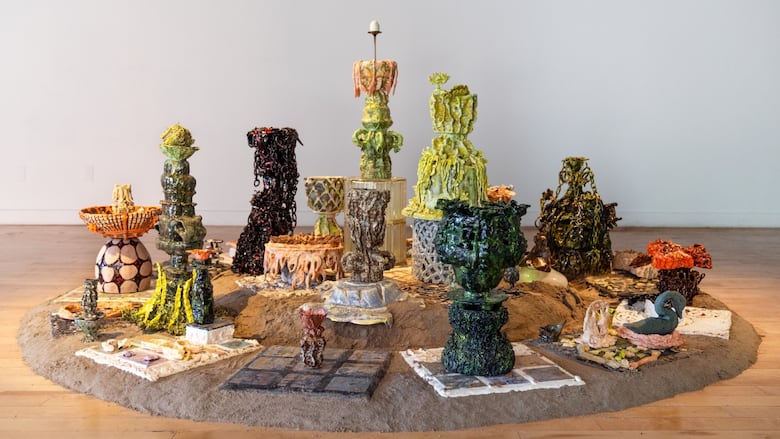The ceramic artist whose sculptures grow and rot — just like we do
When clay is typically lifeless, the art of Nicole Levaque is unusually vibrant

The sculpture — a small, twisted vessel — looks spongy, like the flesh of a mushroom. One appears woolly, as if flocked with moss. Another resembles a beetle's shell, metallic and smooth. There are fingers and tendrils, flowers and eggshells, vertebrae and tongues all over.
When clay is typically thought to be inert or lifeless, the sculptures of ceramic artist Nicole Levaque are unusually vibrant. They look like they're alive. And, in some respects, they are.
At Hamilton Artists Inc., the city's long-standing artist-run centre, an impressive display of the sculptor's ceramic works are installed in vignettes around the main gallery space. The solo exhibition, You and I are Earth, revisits the ancient metaphor of clay as flesh. Through a variety of organic forms that suggest growth and decay, the artist explores how we experience our own bodies as vessels that are both fragile and strong — and connected to all other kinds of life here, too.

Some of the works in the exhibition are brand new, while others are like old friends. The Hamilton-based artist points out a series of tiles she first exhibited at the Visual Arts Center of Richmond in Virginia in 2020. The square plaques have now become place settings around an ornate, banquet-like installation. (Or maybe tomb markers around a funerary altar?)
"I treat all of my pieces as a kind of inventory and as a raw material to work from," she says. Levaque is constantly reconfiguring and reworking her creations, adding raw clay to finished surfaces, refiring and glazing anew. "I think it's really important to revisit the old and grow with them."
Evolving over years, some sculptures have been fired more than 10 times. (That's the process whereby soft clay is transformed into durable ceramic through heat.) "I really love the magic that happens in a kiln," she says, "the unpredictability and the unknown."
Repeat firings can be stressful on the objects, so cracks and crumbles are part of life for the ceramic artist. As she sees it, the faults only invite opportunities for repair and renewal — for more clay and more fire.

She regards her growing inventory of sculptures as her cast of characters. So long as they are in her possession, she is committed to taking care of them. Care — for the artwork, the viewer and the self — is central to Levaque's art making.
It's a theme visible all over, says Sanaa Humayun, artistic director of Hamilton Artists Inc. "The care she puts into her art and into her practice is so present in every step … all the way down to the micro details of the work that you can really spend hours in."
Levaque's installations, such as the table-like display that makes the centrepiece of You and I are Earth, conflate the big and small worlds happening all around us (and inside us, too). The sculptures reference the anatomies of plants and animals, as well as the structures of cells, and littler still, the geometry of molecules. At the same time, the artworks resemble satellite imagery of cities and neighbourhoods.

"There's a phrase I always go back to, and that's 'a world within a handful of moss,'" she says. "It's that idea of taking a really close look at, you know, a mundane piece of your yard, or like, a crack in the alleyway, and discovering a whole cityscape in it." She is interested in the orders of lifeforms and ecosystems that are everywhere, tangled up together.
The exhibition takes its title from a 17th-century earthenware plate decorated with the phrase "You & I are Earth" that was discovered in a London sewer. The artifact had a viral moment a few years ago and made it onto a designer handbag. Widely interpreted as a memento mori, Levaque likes to think of it as the "live, laugh, love" of the plague era. In the context of the show, it frames so much of the dialogue her art engages in: the poetic connection between clay and the body, the ecological relationship between different kinds of matter, the biological processes that govern life and the existential concerns that arise from our eventual return to the earth. Her work often contemplates the way our bodies, too, crack and crumble.


Since Levaque was a child, she has lived with chronic pain, and her art regularly reflects on this experience. The red light emanating from atop an egg-like sculpture, for example, and the green lights elsewhere casting the mossy hue of a lost garden are borrowed directly from the light therapy treatments she uses for pain management and rejuvenation. Another sculpture, resembling a ceremonial fountain or torch, stands on three spinal columns. The bony supports remind us "there's so much that can go wrong," she says.
But the work isn't only about bodies that fall apart. Even more so, she says, it's about finding compassion and care for our bodies — recognizing their strengths, resilience and adaptiveness, too.
"I've gone through a bit of a journey, trying to understand how it is part of me instead of something I'm fighting or constantly separating … or feeling like a failure because of."
Both brittle and durable, Levaque has found in ceramics the perfect medium to give these thoughts a form.
"There's this fragility," she says, "but also the most ancient artifacts we have are made of clay."
The exhibition You and I are Earth by Nicole Levaque is on view through August 9 at Hamilton Artists Inc.